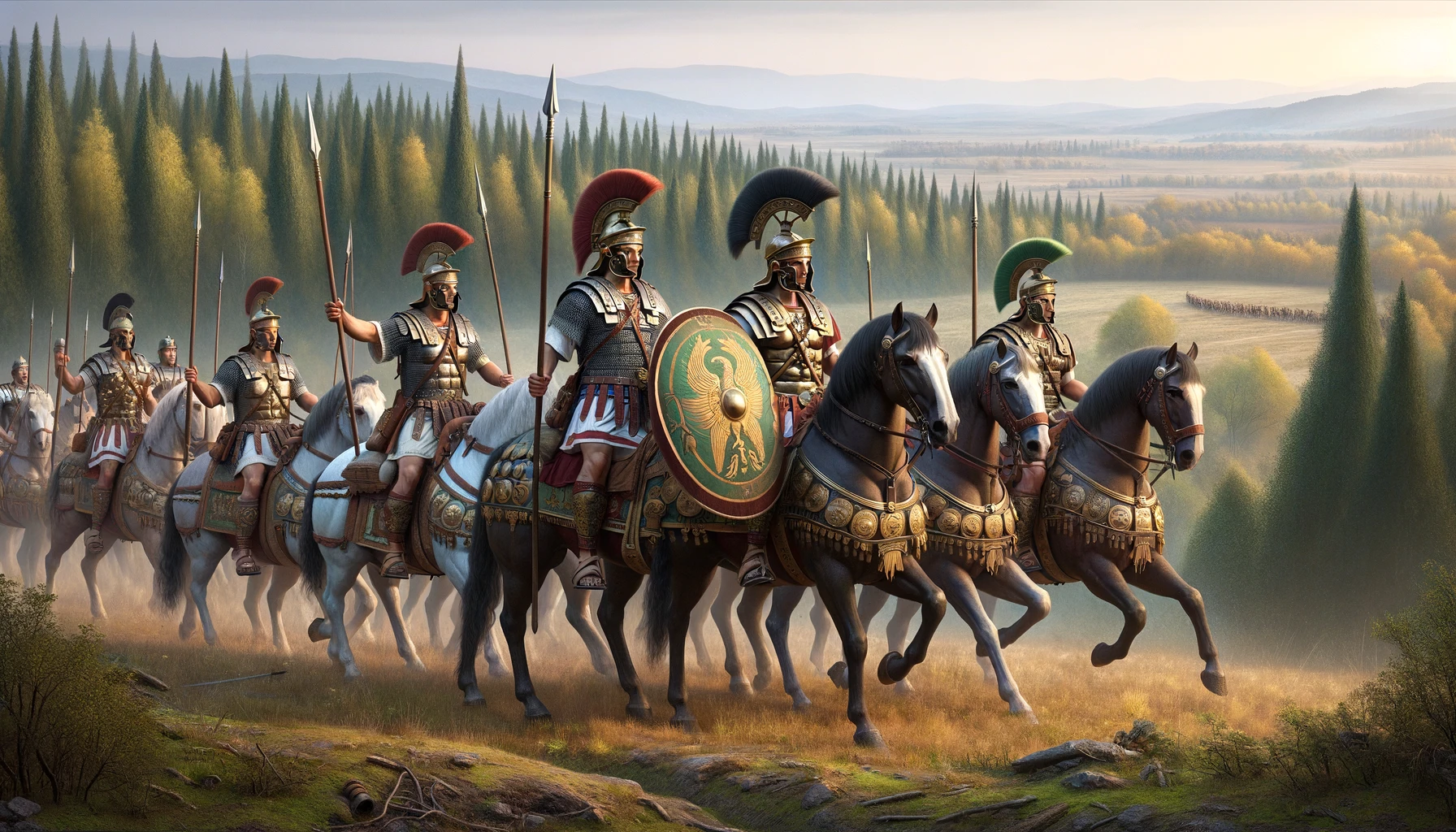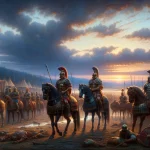Roman Cavalry – Armour
Cavalry helmets
The design of the cavalryman’s helmet was not uniform but varied, being crafted from iron and often adorned with silver or bronze decorations. Some helmets were also entirely made of bronze. Initial helmet models provided minimal protection, but as time progressed into the 1st and 2nd centuries AD, the designs evolved to offer enhanced defence for the wearer. Added reinforcement came in the form of iron or bronze strips across the top of the helmet, significantly improving protection. Additionally, a flange extending from the helmet’s base safeguarded the wearer’s neck; the size and style of this flange differed among helmets. Cheek pieces, another protective feature, were attached to the helmets, growing larger in some styles by the later 2nd century. Furthermore, helmets could be embellished with plumes or feathers for visual distinction.
Armour of the Hippilca Gymnasia
Hippika Gymnasia were sporting events in ancient Rome where cavalry riders trained through mock combat. In these exercises, soldiers would divide into two teams, taking on the personas of Greeks and Amazons, and engage in staged battles using javelins tipped with blunt wooden ends.
The helmets used in the hippilca gymnasia which were cavalry games held on special occasions, were very,’ ornate and made of iron or bronze, with various silver and bronze fittings. These helmets were also called sports helmets and were usually fully enclosed with a removable visor. The visor was often modelled on a face which could be a man or a woman and the helmet had holes for the eyes, nose and mouth. The cavalry helmets for war and also the sports cavalry helmets were lined for comfort with a compressed woollen lining. The helmet would have been kept in place by means of a leather fastening under the chin.
Late Roman helmets
Late Roman helmets were dramatically different from the early styles. The Berkasovo style of helmet which has been found abroad and in England at Burgh Castle, has two sides joined in the middle, reinforced by a raised central ridge for protection against sword blows. It has large cheek pieces and an attached neck plate and a nasal piece to the front of the helmet.
Cavalry Body Armour
Lorica hamata (chain mail) was made of rings of iron or bronze which were linked to provide protection There seems to have been different styles of lorica hamata shirts; some were short, coming down to the hip with side slits. Some shirts would be fairly plain and some would have shoulder reinforcements added. These would come half-way down the top of the arm and were fitted with hooks which were then fastened to the centre of the mail shirt. A backing of leather would be attached to the back of the mail shirt as a form of comfort or protection for clothing that was worn under it.
Cavalry Shields
Shields —came in various sizes and shapes; oval, hexagonal and round. Shields were constructed from wood, glued together with strengthening struts on the back. A bronze or hide binding could be attached around the edge of the shield as a prevention against the shield splitting. The shield had a central steel boss (umbo) which served as a hand guard as the shield was carried by holding a wooden grip behind the boss. The shield would be covered with hide or linen and then a design would be pained onto this, probably a regimental emblem or a different design. A leather shield cover would be fitted over the shield when not in use.
Roman Cavalry – Weaponry
The Romans had a vast array of weaponry for the cavalry:
- Hasta: Spears or lances which were approximately 6-8 feet long. Lances were a shock weapon guaranteed to strike terror against an opponent. They also varied in weight and head size. Javelin —The javelins varied in length and head size. They were carried in a quiver (leather carrying case).
- Contus: A 12 foot long lance, held with both hands, to charge at an opponent.
- Spatha: A sword, which ranged in length from 26 inches to 36 inches and 1.5 to 3 inches in width. A slashing sword with a long reach, worn on the right side of the body. In the 2nd Century, the spatha started to be carried on the left side of the body. The grip was made of ivory or bone and the scabbard, which sheathed the sword, was made of wood and covered with leather. At the top of the scabbard the neck was made of silver or bronze and at the bottom of the scabbard was the chape, also made of silver or bronze. The spatha was attached either from a baldrick or waist belt.
Roman Cavalry Stables
Roman cavalry stables were built so that the cavalrymen were living next to their mounts, this makes sense as in a normal everyday regime or an emergency the cavalry-men could prepare their mounts in an efficient time. The floor of a stable for the cavalry mounts measured 10ft by 12ft, general opinion seems to be that 3 equines were housed in this space!
On the floor of each stable was a pit so that the urine from the ponies could soak away.
Roman Cavalry Saddle
The Roman cavalry saddle would have come in varying sizes and was probably constructed on a rigid wooden frame covered in leather. The Romans rode without stirrups and their saddles had a fixed horn at each corner. The horns would help the rider keep his position and enable him to use them as a support if it was needed. The front horns would support the inner thighs of the legs and the two horns at the back would support the back of the seat/hips. Thus providing a secure saddle to ride in. The horns also acted as a support for the rider to brace himself when delivering or receiving blows to either side of his mount. The horns were probably made of wood and a bronze plate fitted to the front of the front horns and to the back of the rear horns.
The saddle was kept in place with a leather girth strap and the trappings would consist of a breastplate to prevent the saddle slipping backwards and a crupper to prevent the saddle slipping forwards. The trappings were sometimes decorated with phalerae which were bronze or silvered discs or pendants emblazoned with heads of Gods or other designs.

